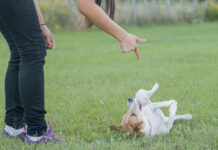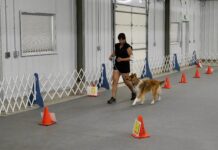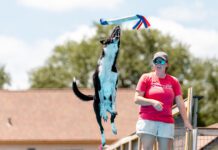Agility is probably the most popular and best known of all the sports for canine athletes. It’s easy to see why. Your dog gets to do what dogs like to do: move around, jump, run, climb on things, and play!
Agility is a high-speed sport in which the handler directs her dog through an obstacle course of jumps, tunnels, weave poles, teeter-totter, and other obstacles. The goal is for the dog to complete the course without exceeding the “standard course time” and without incurring any “faults.” Faults include knocking jump bars, not completing an obstacle, going around a jump instead of over it, and failing to touch “contact zones” – places that the dog must touch as she navigates certain obstacles, to prevent excessive speed and dangerous leaps from the obstacle.
The rules for each level of competition vary; the novice level has more lenient rules and the higher levels of competition are more exacting. At the highest levels of competition no faults are allowed at all in order to “qualify.”
Training your dog for agility is fairly complex. Although your dog readily demonstrates how he can jump over the back of the couch in pursuit of the family cat, he might be stymied by your attempts to lure him over an agility hurdle. If you are willing to invest some time and effort in the training, however, agility can be very rewarding for both dog and human. In fact, the more training you put into the project, the more new avenues of communication open up between you and your dog.
There are two types of agility from which to choose: recreational and competitive. Some classes focus distinctly on one while others let you decide later if you want to compete.
History
According to most accounts, agility got its start as a demonstration to entertain the audience at the United Kingdom’s Crufts dog show in 1978. (Although other reports credit a demonstration by the Royal Air Force Police Dog Demonstration Team, it was the Crufts demonstration that caught Britain’s attention and led to more widespread interest in agility training for the average dog and dog owner.) By 1979, several dog training clubs were offering agility training and by 1980 Britain’s Kennel Club had established rules for competition.
During the 1980s, agility activity picked up in the United States, with several organizations (and varying philosophies and rules) in place by the early 1990s, including the United States Dog Agility Association (USDAA) and the North American Dog Agility Council (NADAC).
Competition
Each of the sanctioning organizations (see list on page 22) has specific requirements for qualifying a dog for a title at each level of competition, i.e., novice, advanced, and masters. At each of these levels there are a variety of “classes” or games in which you can compete.
For example, USDAA has one “standard” class and four “games” in each of its three levels or “divisions,” i.e., novice, advanced, and masters. The standard class is comprised of 15 to 20 obstacles that the judge has arranged into a “course” of obstacles, run in a set sequence. The four games are Jumpers (all jumps and tunnels), Snooker (a strategy game), Gamblers (a distance game), and Pairs Relay (two handlers in a relay race). There are also three “tournament” classes that test advanced handling, i.e., Grand Prix, Steeplechase, and Team (three handlers compete as a team in five classes).
Among the various agility organizations, Canine Performance Events (CPE) and NADAC offer the most agility classes, closely followed by USDAA, with AKC offering the fewest.
All of the agility organizations impose a “standard course time” that the team must not exceed for each class, as well as a variety of other rules, such as not knocking bars; touching the yellow “contact zones” on the A-frame, dogwalk, and teeter; and taking only the obstacles indicated on the course. Titles and placements (e.g., 1st place, 2nd place) are awarded at each level; additional, advanced titles are available in each of the agility organizations.
Training
Agility training involves teaching the individual at each end of the leash. The human must implement all the obstacle training taught in class, and learn handling skills such as when and how to use verbal and physical cues to direct her dog around the course. The canine must be taught how to perform each obstacle (see page 19).
In addition, the dog must be taught to immediately respond to all those verbal and physical cues in a fast-moving, changing environment. No two courses are ever the same, so the handler must make decisions about handling based on the course in front of her. The dog must closely attend to the handler in order to detect cues that come one after the other.
If you have competed in other dog sports, the learning curve may not be as steep as it is for people who have never trained for a performance sport. That said, the agility world is filled with people who tried agility as their first dog sport and became hooked.
Natalie Reusch of Hacienda Heights, California, is a good example of a dog sports neophyte who was captivated by agility. Reusch was not allowed to have a dog when she was growing up; her first dog didn’t come home until Reusch was married. “Go-fer” lived to the ripe old age of 18, and her second dog, Cami, lived to 13. Natalie and her husband, Dave, called Cami their “million dollar dog” because of the costs involved in addressing all her health issues. Dog sports were not even a topic of discussion.
Then came Boxie, a Boxer/Dachshund-mix. “Boxie was my inspiration because even though I knew nothing about agility, I could recognize potential when I saw it. And she definitely had that.”
Reusch started by enrolling Boxie in a class for basic pet manners, and then one for advanced manners. She found that both she and Boxie enjoyed the training process, which she had never done with her prior dogs. By the time she started agility training, Boxie had the basics under her collar, so to speak. It is difficult, if not impossible, to train your dog in agility if you and your dog have not mastered these prerequisites.
Before enrolling your dog in an agility class, you and your dog should be able to work in a distracting environment (both handler and dog have to be able to focus well!) and have mastered basic pet manners behaviors. These include sit, down, stay, come when called, and leash manners. The most challenging aspect of an agility class is keeping your dog focused on you and able to learn new skills in a group class environment. Dogs that are tremendously motivated by toys and food do the best. Additionally, depending upon your instructor, previous clicker training will be advantageous since that training technique is used more and more in this sport.
Recreational or competitive?
There are two broad categories of agility training: recreational and competitive. Recreational classes often focus on getting dogs on all the agility equipment as quickly as possible, using luring and leash guidance. Handling skills that cue the dog to turn, decelerate, switch to the other side of the handler, etc., are taught later, or, in some cases, not at all. These kinds of recreational classes are best for people who want a weekly class that provides fun and entertainment.
Competition classes tend to focus initially on “foundation” skills, including handling. This means that the instructor spends more time focusing on how to use your body to cue your dog. For example, you will learn the proper footwork for cueing your dog forward, for turning, and for decelerating versus accelerating. Foundation skills also include wobble board training (before allowing your dog to get on the teeter-totter) and target training (used later to teach the A-frame and dogwalk). Instructors who specialize in training for competition tend to offer much more structured classes that require students to do a fair amount of homework to keep up with the class.
Some instructors are adept at teaching students who don’t intend to compete at the same time as teaching students with competition goals. Once their dogs become competent on the equipment, however, students who plan to compete in agility require specialized, in-depth instruction. If you know from the outset that you want to compete, you will probably benefit more from an instructor who actively competes herself. Also, keep in mind that retraining is always much more difficult than training your dog correctly from the start.
Team attributes
Your dog should be physically fit and enjoy physical and mental stimulation. Agility is a physically demanding sport. If your dog is overweight, her joints are subjected to much more abuse than those belonging to dogs who are in optimum condition. Make sure you exercise your dog appropriately and regularly, so she is fit enough to withstand the demands of a weekly class. Swimming, jogging, and running up and down hills are excellent conditioning exercises. As agility has matured, more information has become available about the benefits of physical conditioning, massage, and chiropractic care for canine athletes.
Handlers must be able to sprint, stop quickly, accelerate quickly, turn, and twist. This sport can be hard on aging knees and backs. Many students who choose to compete recognize the benefits of a conditioning program for themselves as well as their dogs!
Supplies and equipment
Some agility equipment is heavy, most of it is costly, and there is a lot of it. That said, most people don’t buy the more expensive and heavy, space-hogging equipment such as the teeter, A-frame, dogwalk, and competition-grade tunnels; they train on this equipment only at facilities that offer agility instruction.
More frequently they practice at home with the lower cost agility obstacles: jumps, weave poles, and a tunnel. Four to six jumps and a set of weave poles will cost about $300 to $500. A good 15-foot tunnel will cost another $200 to $250. With those basic pieces of equipment, you can practice a variety of handling maneuvers, as well as help your dog become proficient in the weave poles. It will take a long time to train your dog to negotiate the weave poles if you practice only once a week in a class; having your own set will drastically reduce your training time.
Expenses
The most expensive part of this sport is investing in the basic equipment listed above and paying for ongoing classes. Beyond that, trial entry fees and travel and lodging are the big-ticket items. Competition fees run anywhere from $8 per class to $20 depending upon the sanctioning organization (AKC fees tend to be the highest) and the type of class. For example, it costs an average of $14 for a standard class in USDAA and $8 to $10 for each of the four games. The first class you enter in an AKC trial will cost $20, and the second class will cost $15.
In all venues except AKC, you will have the opportunity to run three to six classes per day. For example, five classes a day at a CPE trial would cost you about $50. Enter for both days of a weekend, and there goes $100.
Gas and lodging will probably be your next biggest expense. However, if you do AKC trials, which are rather plentiful in most areas of the country, you might not have to travel too far. And if you expand your horizons to include several of the different agility venues (USDAA, CPE, ASCA, etc.), you might be able to stay closer to home than if you only compete in one of them.
Agility classes tend to cost more than an average dog training class; they require a lot of expensive equipment, a large space, and the cost of maintaining that space and equipment. As a result, a weekly agility class that runs for six to eight weeks may cost as much as $225. Plan on staying enrolled in classes for months or even years; access to all that equipment is what keeps people coming back week after week. Check for public classes through your city/town, private training facilities, and even some larger shelters offer classes. You can also go to the Clean Run website (cleanrun.com) to search for trainers near you.
How to get started
Due to the maturity of this sport, there are many books, DVDs, seminars, and schools available. Try a basic or introductory class, or just go and watch one, to see if agility is something you and your dog might enjoy. Check to see if the class has a waiting list; the popularity of agility has resulted in waiting lists for many classes. While you wait for a class to start, refresh your dog’s basic pet manners, enroll in a clicker training class, and start a conditioning program for you and your dog.
If your dog has more mental and physical energy than you know what to do with, and you enjoy physical activities, this is probably your sport.
Reusch aptly describes agility’s appeal. “Agility offers a way of bonding with my dog, and working together as a team to develop skills, solve problems, and overcome obstacles. The better we get, the more fun it becomes. We aren’t doing this for a championship; we’re doing it because it’s fun and exhilarating. I enjoy the feeling of connecting with my dog when we’re running a course together, everything clicking into place. And then there is the big smile on my dog’s face and the excitement in her eyes after she finishes a run. That’s priceless.”





